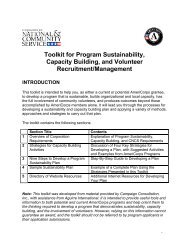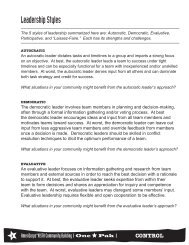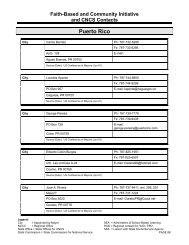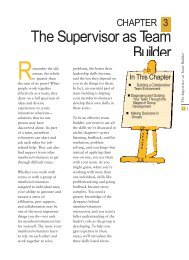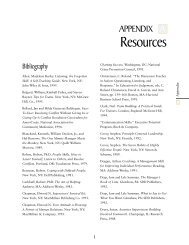MAKE IT LAST FOREVER: THE ... - National Service Resource Center
MAKE IT LAST FOREVER: THE ... - National Service Resource Center
MAKE IT LAST FOREVER: THE ... - National Service Resource Center
You also want an ePaper? Increase the reach of your titles
YUMPU automatically turns print PDFs into web optimized ePapers that Google loves.
Links to<br />
Educational Standards:<br />
Professional Development:<br />
Strategic Planning:<br />
State/District/<br />
Non-Profit Personnel:<br />
Organizational Culture:<br />
Funding:<br />
boards to examine each curricular area and use and/or publish guides and curricula which illustrate how<br />
service links to each academic subject at every grade level. At a minimum, provide for specific servicelearning<br />
experiences in a certain grade level throughout a school district.<br />
Provide examples in published state standards of how service can meet content performance standards<br />
for all subject areas in at least three K-12 benchmark grade levels. Publish resource guides which<br />
demonstrate these connections. Provide forms for teachers to make the formal links. Develop school or<br />
district standards of effective practice.<br />
Develop an annual program of introductory and advanced professional development using peers,<br />
colleges, non-profit experts, and students to train teachers, students, administrators, school boards, state<br />
department of education personnel, school and after-school staff, trainers, volunteers, and community<br />
partners. Provide multiple training opportunities, such as conferences, personal consultations, regional<br />
constituency meetings, in-service trainings, and summer institutes. Give incentives, such as academic<br />
credit or stipends, for these trainings. Publish printed and audio-visual “how-to” materials.<br />
Educators, students, and the community together form advisory boards which create school, district, and<br />
state strategic plans for service-learning that directly address real issues and needs. Planning time and<br />
funding should be allocated for this purpose. The plan should address the long-term sustainability of the<br />
pedagogy rather than focus on building a program. The plans should be periodically monitored and<br />
altered to suit site conditions.<br />
State-level and district full-time employees are needed to coordinate service-learning initiatives during<br />
the initial years of institutionalization. Other personnel can also provide support to infrastructure, such<br />
as curriculum specialists, resource teachers, non-profit staff, VISTA members, and steering committees<br />
and task forces. Educational leaders at these levels are critical in terms of their endorsement of servicelearning.<br />
Hire teachers who are interested in the community being the curriculum and who have<br />
experience and/or interest in service-learning and other forms of educational reform.<br />
Share the responsibility of designing, implementing, and evaluating the development of a servicelearning<br />
initiative. While principals can provide leadership in establishing it as a priority, faculty belief<br />
in the importance of community involvement can ensure that service-learning becomes standard practice<br />
at any school. Teachers who do not share this belief should perhaps be reassigned.<br />
Ideally, schools should transition away from state and federal funding for service learning in favor of<br />
school budget support for personnel, materials and transportation. Funding can also come from other<br />
permanent sources, such as the “title” programs, and from private philanthropy fund raising activities,<br />
101



